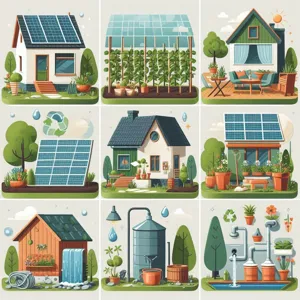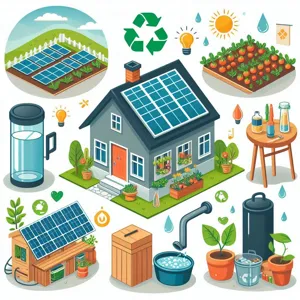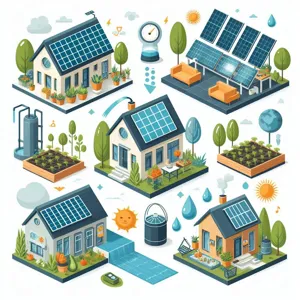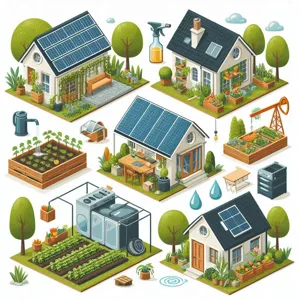As environmental concerns continue to rise, more and more people are seeking practical ways to reduce their ecological footprint right from the comfort of their homes.
Making your living space eco-friendly doesn’t have to be an overwhelming endeavor; in fact, small, intentional changes can lead to a significant positive impact on both the planet and your lifestyle. From choosing sustainable materials to adopting energy-saving practices, creating an eco-conscious home is not only beneficial for the environment but can also enhance your well-being and reduce utility costs. In this blog post, we will explore 10 simple and effective ways to transform your home into a greener sanctuary. Whether you’re a seasoned eco-warrior or just starting your journey towards sustainability, these tips will empower you to make a difference, one room at a time. Join us as we delve into practical strategies that will help you embrace an eco-friendly lifestyle without sacrificing style or comfort!
1. Introduction to Eco-Friendly Living

In an age where environmental concerns are at the forefront of global discussions, the concept of eco-friendly living has gained immense traction. Embracing an eco-friendly lifestyle isn’t just about making dramatic changes; it’s about integrating small, sustainable practices into our daily routines that collectively contribute to a healthier planet. Eco-friendly living means being conscious of our consumption habits, reducing waste, and making choices that minimize our ecological footprint.
From the energy we use in our homes to the products we purchase, every decision we make can have a ripple effect on the environment. By gradually adopting eco-friendly practices, we not only enhance our living spaces but also foster a deeper connection with nature and encourage a mindset of sustainability within our communities.
In this blog post, we’ll explore ten simple yet effective ways to make your home eco-friendly. Whether you’re just starting your green journey or looking to enhance your existing practices, these tips will help you create a more sustainable living environment while reaping the benefits of reduced energy costs and improved well-being. Let’s embark on this journey towards eco-conscious living together!
2. Assessing Your Current Home Practices
Assessing your current home practices is an essential step toward making your living space more eco-friendly. This assessment involves taking a close look at various aspects of your daily routines and household operations to identify areas where you can reduce waste, conserve energy, and adopt sustainable practices.
Start by walking through your home with a critical eye. Examine your energy usage: Are you leaving lights on in unoccupied rooms? What about your heating and cooling systems—are they efficiently maintaining comfort levels without excessive energy consumption? Consider investing in smart home technology, which can help monitor and manage energy use more effectively.
Next, evaluate your water consumption. Check for leaks in faucets and toilets, which can lead to significant water waste over time. Look at your water usage habits—are you taking long showers or running the dishwasher and washing machine with partial loads? Small adjustments, such as shorter showers or only washing full loads, can lead to substantial savings.
Don’t overlook your waste management practices. Take stock of how much trash you generate and what items can be recycled or composted. Implementing a robust recycling system and setting up a compost bin can drastically reduce landfill contributions and promote a more sustainable lifestyle.
Lastly, assess the products you use around the house, from cleaning supplies to personal care items. Many conventional products contain harsh chemicals that can be harmful to both your health and the environment. Opting for eco-friendly cleaning solutions or making your own with natural ingredients can significantly lessen your ecological footprint.
By conducting a thorough assessment of your current home practices, you’ll gain valuable insights into the changes you can make. This foundational understanding will empower you to implement effective strategies that not only benefit the planet but also enhance your home’s comfort and efficiency.
3. Switch to Energy-Efficient Appliances

Making the switch to energy-efficient appliances is a powerful step towards reducing your home’s carbon footprint while also saving money on utility bills. These modern devices are designed to consume less energy than their traditional counterparts, often incorporating innovative technologies that maximize efficiency without sacrificing performance.
When you replace an old refrigerator or washing machine with an Energy Star-certified model, you’re not just making a purchase; you’re investing in a more sustainable home. For instance, energy-efficient refrigerators use advanced insulation and compressors that minimize energy consumption, keeping your food fresh while using significantly less electricity. Similarly, energy-efficient washing machines can cut water usage by up to 50% compared to standard models, all while delivering a superior clean.
The benefits extend beyond mere savings. By reducing energy usage, these appliances often generate less greenhouse gas emissions, contributing to a healthier planet. Imagine the satisfaction of knowing that every time you do laundry or cook a meal, you are actively participating in a positive change for the environment.
Moreover, many utility companies offer rebates and incentives for consumers who choose energy-efficient appliances, making the initial investment even more appealing. With a wide variety of options available on the market today, you can find energy-efficient models that match your style and fit seamlessly into your home.
Ultimately, transitioning to energy-efficient appliances not only enhances your home’s eco-friendliness but also promotes a lifestyle that values sustainability and responsible consumption—principles that are more important now than ever. Embrace this change, and watch as your home transforms into a more environmentally conscious sanctuary.
4. Incorporating Renewable Energy Sources
Incorporating renewable energy sources into your home is one of the most impactful steps you can take toward sustainability. By harnessing the power of the sun, wind, or water, you can significantly reduce your carbon footprint while also enjoying the financial benefits of lower energy bills.
Solar panels are perhaps the most recognized form of renewable energy for residential homes. Installing photovoltaic panels on your roof allows you to capture sunlight and convert it into electricity. With advances in technology, solar energy systems have become more efficient and affordable than ever. Many homeowners find that the initial investment pays off in just a few years, especially with available tax incentives and rebates. Additionally, excess energy generated can often be sold back to the grid, providing an extra financial cushion.
Wind turbines are another option, particularly for those living in areas with consistent wind patterns. Small-scale residential wind turbines can produce enough energy to power your home, especially when paired with other renewable sources. It’s essential to assess your local zoning laws and the suitability of your property for wind energy before making a commitment, but for some, this can be a fantastic source of clean energy.
For those near water sources, hydropower can also be an excellent option. Micro-hydropower systems can generate electricity from the flow of water in streams or rivers on your property. This approach is less common but can be incredibly effective for the right location.
Beyond installations, consider integrating smart technology to optimize energy use in your home. Smart thermostats, energy-efficient appliances, and home automation systems can help you monitor and reduce energy consumption, further enhancing your eco-friendly lifestyle.
By incorporating renewable energy sources, you not only contribute to a greener planet but also create a more self-sufficient and resilient home, ensuring that you are prepared for the future while making a positive impact today.
5. Reducing Water Usage with Smart Solutions

Reducing water usage is not only crucial for conserving this precious resource, but it also benefits your wallet and the environment. Implementing smart solutions in your home can lead to significant reductions in water consumption without sacrificing comfort or convenience.
Start by installing low-flow fixtures in your bathrooms and kitchens. These innovative devices—such as showerheads, faucets, and toilets—are designed to use less water while maintaining optimal performance. For instance, a low-flow showerhead can save up to 2.5 gallons per minute, allowing you to enjoy a refreshing shower while using less water overall.
Next, consider incorporating smart irrigation systems into your outdoor spaces. These systems utilize sensors and timers to ensure your garden receives just the right amount of water, adjusting for rainfall and soil moisture levels. This not only conserves water but also promotes healthier plants by preventing overwatering.
Another simple yet effective solution is to collect rainwater. Installing a rain barrel allows you to capture runoff from your roof, providing an eco-friendly source of water for your garden or outdoor cleaning tasks. This practice not only reduces your reliance on municipal water sources but also helps to manage stormwater runoff, benefiting the local ecosystem.
Don’t forget to make small lifestyle changes that can have a big impact. Turn off the tap while brushing your teeth, fix leaks promptly, and opt for shorter showers. By being mindful of your water usage and adopting these smart solutions, you can create a more sustainable home that not only minimizes your environmental footprint but also fosters a culture of conservation within your family.
6. Choosing Sustainable Materials for Home Renovations
When it comes to home renovations, the materials you choose can significantly impact the environment. Opting for sustainable materials not only reduces your carbon footprint but also enhances the overall aesthetic and value of your home. To start, consider reclaimed wood for flooring, beams, or furniture. This not only gives a unique character to your space but also diverts materials from landfills, breathing new life into what might otherwise be discarded.
Bamboo is another excellent choice, renowned for its rapid growth and renewability. It can be used for everything from flooring to cabinetry and offers a sleek, modern look while being incredibly durable. For countertops, consider recycled glass or concrete options that incorporate repurposed materials, providing a stunning finish that tells a story of sustainability.
Additionally, when selecting paints, adhesives, and finishes, look for low-VOC (volatile organic compounds) products. These eco-friendly options minimize harmful emissions, contributing to better indoor air quality—a vital aspect of a healthy home environment.
Don’t overlook insulation either; sustainable insulation materials, such as sheep’s wool or cellulose made from recycled paper, can help maintain energy efficiency while lessening environmental impact.
By consciously selecting sustainable materials, you create a home that not only reflects your personal style but also embodies a commitment to environmental stewardship—ultimately leading to a healthier planet for future generations. Embrace these eco-friendly options in your next renovation project, and watch as your living space transforms into a haven of sustainability.
7. Implementing a Comprehensive Recycling System

Implementing a comprehensive recycling system in your home is a pivotal step toward creating a more eco-friendly environment. It begins with assessing the types of materials your household consumes and discards most frequently. Common recyclables include paper, cardboard, glass, plastic, and metals. By setting up a dedicated recycling station in a convenient area of your home—such as the kitchen or garage—you can streamline the process and make it easier for everyone in the household to participate.
Start by placing clearly labeled bins for each type of recyclable material. Use vibrant colors and easy-to-read signs to help distinguish between them. Consider using additional containers for composting organic waste, which can significantly reduce the volume of trash your household generates. Composting not only diverts waste from landfills but also enriches your garden soil, promoting healthy plant growth.
Education is key when it comes to recycling effectively. Take the time to explain the importance of recycling to your family and encourage them to be mindful of what they throw away. You can even involve kids in the process by turning it into a fun educational game—challenge them to sort materials correctly or track how much they recycle each week.
Additionally, stay informed about your local recycling guidelines, as they can vary significantly from one municipality to another. Many areas also host recycling events or drop-off centers for items that are not accepted in curbside collection, such as electronics or hazardous materials. Participating in these initiatives not only supports your community’s recycling efforts but also ensures that you are disposing of items responsibly.
By implementing a comprehensive recycling system and fostering a culture of sustainability within your home, you can make a lasting impact. Each small effort contributes to a larger movement toward reducing waste and conserving resources, making your home a beacon of eco-friendliness in your community.
8. Embracing Indoor Plants for Air Quality
Bringing the beauty of nature indoors is not only aesthetically pleasing but also a powerful way to enhance your home’s air quality. Indoor plants are more than just decorative pieces; they play a crucial role in purifying the air we breathe. By incorporating a variety of plants into your living space, you can effectively filter out toxins, increase humidity, and even boost your mood.
Certain plants, like the peace lily, snake plant, and spider plant, have been shown to be particularly effective at removing harmful pollutants such as formaldehyde, benzene, and carbon monoxide. These resilient greens are not only low-maintenance but also thrive in a range of indoor conditions, making them perfect for any home.
In addition to their air-purifying qualities, indoor plants can help regulate humidity levels, promoting better respiratory health and reducing the likelihood of dry skin. The presence of greenery can create a calming atmosphere, which contributes to overall well-being and relaxation.
When choosing plants for your space, consider varying sizes and types to create an inviting and lively environment. Hang trailing plants from shelves, place tall ones in corners, or cluster smaller pots on a windowsill. Not only will you enjoy the beauty of these natural additions, but you’ll also be taking a significant step toward creating a healthier and more eco-friendly home. So, roll up your sleeves, green thumbs or not, and let nature thrive within your walls!
9. Utilizing Eco-Friendly Cleaning Products
When it comes to creating an eco-friendly home, the cleaning products you choose can have a significant impact on both your health and the environment. Traditional cleaning products often contain harsh chemicals that can pollute indoor air quality, irritate skin, and contribute to environmental degradation when washed down the drain. By making a switch to eco-friendly cleaning products, you not only promote a healthier home but also support sustainable practices that protect our planet.
Eco-friendly cleaning products are typically made from natural ingredients that are biodegradable and free from toxic substances. Look for brands that prioritize transparency in their ingredient lists and avoid synthetic fragrances, dyes, and preservatives. Many eco-friendly products are just as effective at tackling dirt and grime as their conventional counterparts. For instance, vinegar and baking soda are powerful natural cleaners that can be used for a variety of tasks, from unclogging drains to removing stubborn stains.
Another fantastic option is to make your own cleaning solutions using simple ingredients. A mixture of water, vinegar, and a few drops of essential oil can serve as a versatile all-purpose cleaner, while lemon juice can act as a natural disinfectant. By DIY-ing your cleaning products, you can control the ingredients you use and reduce plastic waste by reusing bottles and containers.
Furthermore, consider investing in brands that use sustainable packaging and promote refillable options. Many companies now offer eco-friendly cleaning products in bulk, allowing you to refill your containers and minimize single-use plastic. By choosing these alternatives, you not only contribute to a healthier living environment but also play a part in the broader movement towards sustainability.
Incorporating eco-friendly cleaning products into your home is a simple yet impactful step toward fostering a more sustainable lifestyle. As you clean, you can feel confident knowing that your choices are contributing to a healthier planet for future generations.
10. Reducing Single-Use Plastics in the Home
Reducing single-use plastics in the home is one of the most impactful changes you can make for the environment. These disposable items, often used for only a few minutes before being discarded, contribute significantly to pollution and landfill waste. By adopting more sustainable practices, you can help diminish your plastic footprint and promote a healthier planet.
Start by taking inventory of the single-use plastics you currently rely on—think plastic bags, straws, water bottles, and food containers. Once you identify these items, consider practical alternatives. Swap out plastic bags for reusable cloth totes when grocery shopping, and invest in a sturdy stainless steel or glass water bottle to stay hydrated without the waste. For food storage, choose glass containers or beeswax wraps instead of plastic wrap. Not only do these alternatives reduce waste, but they often keep your food fresher for longer.
Another effective strategy is to make a conscious effort to buy in bulk, which can significantly cut down on packaging waste. Opt for bulk bins at your local grocery store for items like grains, nuts, and snacks, using your own reusable containers to fill them. If you enjoy takeout, consider bringing your own reusable containers to the restaurant, which can help eliminate the need for plastic containers entirely.
Educating your family and friends about the importance of reducing single-use plastics can also create a ripple effect. Share tips and resources, or even host a zero-waste challenge to inspire everyone to think critically about their plastic consumption.
By making small yet meaningful changes, you can play a crucial role in reducing the demand for single-use plastics and contribute to a more sustainable future. Every choice counts, and as you embrace eco-friendly habits, you’ll find yourself not only helping the planet but also inspiring those around you to join in the effort.
11. Creating a Composting System
Creating a composting system is one of the most rewarding and impactful steps you can take to make your home more eco-friendly. Not only does composting significantly reduce the amount of organic waste that ends up in landfills, but it also transforms food scraps and yard waste into rich, nutrient-dense soil that can enhance your garden and houseplants.
To get started, choose a compost bin that fits your space—this could be a simple DIY setup using wooden pallets, a store-bought bin, or even a worm composting system if you have limited outdoor space. If you have a larger yard, consider creating a designated compost pile.
Once you’ve established your bin or pile, it’s time to begin collecting materials. The key to successful composting is balancing “greens” and “browns.” Greens include nitrogen-rich materials like fruit and vegetable scraps, coffee grounds, and grass clippings. Browns are carbon-based materials such as dry leaves, straw, and cardboard. Aim for a ratio of roughly three parts browns to one part greens. This balance promotes healthy microbial activity, which is essential for the composting process.
As you add materials, remember to aerate your compost regularly by turning it with a pitchfork or shovel. This introduces oxygen, helping bacteria break down the organic matter more efficiently. Keep an eye on moisture levels, too—your compost should be damp, but not soggy. If it’s too dry, add water; if it’s too wet, incorporate more browns.
In just a few months, your compost will decompose into a dark, crumbly substance that smells earthy and rich. Use this finished compost to enrich your garden beds, potted plants, or landscape, reducing the need for chemical fertilizers and enhancing soil health.
By creating a composting system, not only do you contribute to a more sustainable environment by reducing waste, but you also foster a greater appreciation for the natural cycles of life and the importance of nurturing the earth. Your garden—and the planet—will thank you!
12. Smart Thermostats and Energy Management
One of the most impactful steps you can take toward an eco-friendly home is investing in smart thermostats and energy management systems. These innovative devices go beyond mere temperature regulation; they are designed to optimize your energy usage, reduce waste, and ultimately lower your utility bills.
Imagine arriving home after a long day, and the smart thermostat has already adjusted your heating or cooling settings, ensuring a comfortable environment while minimizing energy consumption. Equipped with advanced sensors and learning algorithms, these thermostats can analyze your daily routines and preferences, automatically adjusting temperatures based on when you’re home and when you’re away. This means no more heating or cooling an empty house, which can significantly reduce your carbon footprint.
Additionally, many smart thermostats are compatible with mobile apps that allow you to monitor and control your energy usage from anywhere. You can easily adjust settings while at work or on vacation, ensuring that you’re only using energy when necessary. Some systems even provide insights into your energy consumption patterns, helping you identify areas where you can improve efficiency.
By pairing smart thermostats with energy management systems, you can also integrate various smart appliances and devices throughout your home. This interconnected approach allows for seamless communication between your heating, cooling, and appliance systems, enabling you to create a more efficient home environment. For instance, you can set your smart appliances to run during off-peak hours when energy rates are lower, further reducing your carbon footprint and saving money.
Investing in smart thermostats and energy management not only enhances your home’s efficiency but also contributes to a more sustainable future. As you embrace these technologies, you’ll not only enjoy the comfort of a well-regulated home but also take significant strides toward reducing your environmental impact.
13. Supporting Local and Sustainable Products
Supporting local and sustainable products is not just a trend; it’s a powerful movement that can significantly reduce your carbon footprint while fostering a more resilient community. By choosing to purchase from local artisans, farmers, and small businesses, you’re not only helping to support your local economy but also minimizing the environmental impacts associated with transportation and mass production.
When you opt for locally sourced goods, you’re often getting fresher, higher-quality products that are free from the long supply chains and excessive packaging that contribute to environmental degradation. For instance, buying seasonal produce from local farmers’ markets not only ensures that you’re consuming foods at their peak freshness but also supports sustainable farming practices. Many local farmers prioritize organic methods that reduce pesticide use and promote biodiversity, making your food choices healthier for both you and the planet.
Furthermore, supporting sustainable products can extend beyond food to include household items, clothing, and personal care products. Look for brands that prioritize ethical sourcing, eco-friendly materials, and fair labor practices. Many local businesses take pride in creating items that are built to last, reducing the need for frequent replacements and ultimately decreasing waste.
By consciously choosing to invest in local and sustainable products, you are playing a crucial role in promoting environmental stewardship and encouraging a more sustainable economy. As you fill your home with these mindful choices, not only will you create a healthier living space, but you will also inspire others in your community to consider the impact of their purchasing decisions. Every small step counts, and by supporting local, you are contributing to a larger, positive change for our planet.
14. Engaging in Community Eco-Friendly Initiatives
Engaging in community eco-friendly initiatives is a powerful way to not only enhance your home’s sustainability but also inspire those around you to adopt greener practices. When you participate in local environmental efforts, such as tree planting days, community clean-ups, or recycling drives, you create a ripple effect that extends beyond your own doorstep.
Joining forces with like-minded individuals fosters a sense of camaraderie and shared responsibility for the environment. Whether it’s collaborating with neighbors to start a community garden or organizing educational workshops on composting and waste reduction, these collective actions can significantly impact your local ecosystem. By pooling resources and knowledge, you can learn innovative ways to reduce your carbon footprint and promote sustainable living.
Moreover, volunteering for local environmental organizations not only contributes to the health of your community but also keeps you informed about ecological issues affecting your area. Many communities have dedicated groups focused on conservation, wildlife protection, or renewable energy initiatives. Getting involved in these organizations can provide you with valuable insights and skills that you can implement in your own home, such as energy-saving techniques or water conservation methods.
In addition to the direct environmental benefits, participating in community initiatives can strengthen social bonds and enhance the overall quality of life in your neighborhood. As you connect with others who share your passion for sustainability, you may find new friends and create a support network that encourages everyone to adopt eco-friendly habits. So, take that first step, get involved, and watch as your efforts contribute to a healthier planet while building a vibrant, environmentally conscious community.
15. Conclusion: The Impact of Small Changes on the Environment
In our journey toward creating an eco-friendly home, it’s essential to recognize that every small change we make can have a significant impact on the environment. While the scale of global challenges may feel overwhelming, individual actions collectively contribute to a more sustainable future. By adopting simple habits—such as switching to energy-efficient appliances, reducing water consumption, or incorporating more plant-based meals into our diets—we can collectively reduce our carbon footprint and promote a healthier planet.
Consider, for instance, the power of reducing single-use plastics. By opting for reusable bags, water bottles, and containers, we not only minimize waste but also encourage those around us to follow suit. Each time you choose a sustainable option, you’re not just making a personal choice; you’re also sending a message that eco-conscious living is not only possible but imperative.
Furthermore, engaging in local initiatives, whether it’s participating in community clean-ups or supporting local farmers’ markets, fosters a sense of connection and responsibility towards our environment. These actions not only nurture our surroundings but also inspire others to join the movement.
As we conclude our exploration of making our homes more eco-friendly, it’s crucial to remember that the journey toward sustainability is not a sprint but a marathon. Small, consistent changes can lead to monumental effects over time. So, let’s commit to integrating these eco-friendly practices into our daily lives, knowing that each step we take contributes to a greener, more vibrant world for generations to come. Together, we can make a difference—one small change at a time.
In conclusion, making your home eco-friendly doesn’t have to be an overwhelming endeavor; it can be a fulfilling journey that benefits both your family and the planet. By integrating these 10 simple and effective strategies into your daily routine, you can significantly reduce your environmental footprint while creating a healthier living space. Whether it’s swapping out traditional light bulbs for energy-efficient options, composting kitchen scraps, or choosing sustainable materials for your home improvements, every small change adds up to a larger impact. Embrace these eco-friendly practices and inspire those around you to join the movement toward a more sustainable future. Together, we can cultivate a greener world, one home at a time. Thank you for joining us on this journey—now let’s get started on making our homes a little kinder to the Earth!






